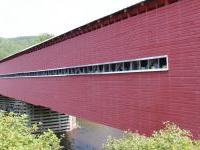 A few kilometres south of the Jean-Chassé Bridge, still on Route 195, is the village of Saint-René-de-Matane. Here we find a 52-metre, 2-span bridge in the heart of the village.
A few kilometres south of the Jean-Chassé Bridge, still on Route 195, is the village of Saint-René-de-Matane. Here we find a 52-metre, 2-span bridge in the heart of the village.
Built in 1942, the François-Gagnon Bridge, as it is called, underwent major repairs in the 1990s, repairs that unfortunately included the addition of a steel and wood sub-structure, renovations that rendered the truss redundant and, according to purists, reduced the authenticity of the bridge. The bridge, however, is still an impressive sight, and the modern additions are not visible.
Continuing south on the 195, the road winds its way over the highlands of the Gaspé peninsula until it descends into the Matapedia River Valley, where it meets Route 132 at Amqui.
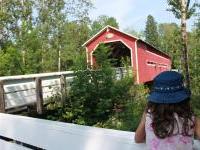 Today, Amqui is home to two covered bridges. The first one is situated in a park on the north side of town. This bridge, the Beauséjour Bridge, has an unusual history. Built in 1932, it originally spanned the du Brûlé River in the municipality of Saint-Odile-de-Rimouski. Facing demolition, the bridge was closed to circulation and left to rot for twenty years. In 1999, it was judged unsafe and moved to a nearby field.
Today, Amqui is home to two covered bridges. The first one is situated in a park on the north side of town. This bridge, the Beauséjour Bridge, has an unusual history. Built in 1932, it originally spanned the du Brûlé River in the municipality of Saint-Odile-de-Rimouski. Facing demolition, the bridge was closed to circulation and left to rot for twenty years. In 1999, it was judged unsafe and moved to a nearby field.
In 2000, Saint-Odile received a request from Gaëtan Ruest, the mayor of Amqui, and an ardent defender of covered bridges. Ruest asked if his town could have the bridge.
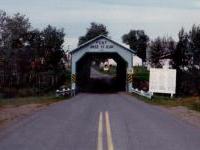 The bridge was then donated to Amqui and transported nearly 100 kilometres to its new location in the Amqui municipal park.
The bridge was then donated to Amqui and transported nearly 100 kilometres to its new location in the Amqui municipal park.
In 2005, the bridge was renovated (again, purists would say over-renovated) and converted to a footbridge over the Matapedia River. The total cost of the project, including transporting the bridge, renovating it, and re-installing it on new piers in its new location, was just over $306,000.
A kilometre or two north of Amqui on Route 132, near the outlet of Lake Matapedia, is Amqui's second (and original) covered bridge. This bridge, the 44-metre Anse-Saint-Jean Bridge, dates to 1931. Saved from demolition in the 1990s, it was then, unfortunately, renovated according to methods that were completely incompatible with authentic covered bridge construction. The bridge, situated on Paradis Road, is nevertheless an attractive one.
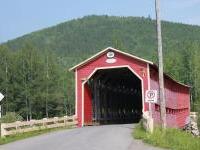 South of Amqui, Route 132 follows the majestic Matapedia Valley. Between the villages of Causapscal and Sainte-Florence, just off the highway on Heppell Road, is the Heppell Bridge. Built in 1909, this is the oldest surviving covered bridge in the Gaspé. Severely damaged in the spring of 1991, the 39-metre span was fortunately repaired and is now a source of pride to local residents. The bridge is named after the Heppell family, which pioneered the area and built the bridge.
South of Amqui, Route 132 follows the majestic Matapedia Valley. Between the villages of Causapscal and Sainte-Florence, just off the highway on Heppell Road, is the Heppell Bridge. Built in 1909, this is the oldest surviving covered bridge in the Gaspé. Severely damaged in the spring of 1991, the 39-metre span was fortunately repaired and is now a source of pride to local residents. The bridge is named after the Heppell family, which pioneered the area and built the bridge.
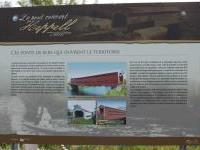 On the west bank of the Matapedia, a small park has been created with the covered bridge theme as its focus. A series of interpretive plaques relate the history of the bridge, the people who built it, and other aspects of local history.
On the west bank of the Matapedia, a small park has been created with the covered bridge theme as its focus. A series of interpretive plaques relate the history of the bridge, the people who built it, and other aspects of local history.
Nearby, an unusual sculpture has been erected featuring the wooden truss of a covered bridge under construction, with workers rendered in bronze.
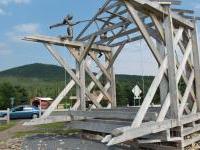 The final covered bridge on this tour, and in some ways the most spectacular, is the Routhierville Bridge. Built in 1931, this bridge was built at a strategic stop on the railway line through the Matapedia Valley.
The final covered bridge on this tour, and in some ways the most spectacular, is the Routhierville Bridge. Built in 1931, this bridge was built at a strategic stop on the railway line through the Matapedia Valley.
The covered bridge has long been a favourite among photographers and tourists passing through the region. It is located on a stretch of the river that is particularly known for its salmon fishing. At 79 metres, the Routhierville Bridge is by far the longest bridge on this tour.
 Thus ends this tour of covered bridges on the Matane-Matapedia route. This route can, of course, be taken in reverse, although most travelers seem to prefer taking the drive in this direction.
Thus ends this tour of covered bridges on the Matane-Matapedia route. This route can, of course, be taken in reverse, although most travelers seem to prefer taking the drive in this direction.
As noted at the beginning of this article, there are a handful of other covered bridges in the Gaspé. These, too, are worth a visit, although they are much more spread apart.